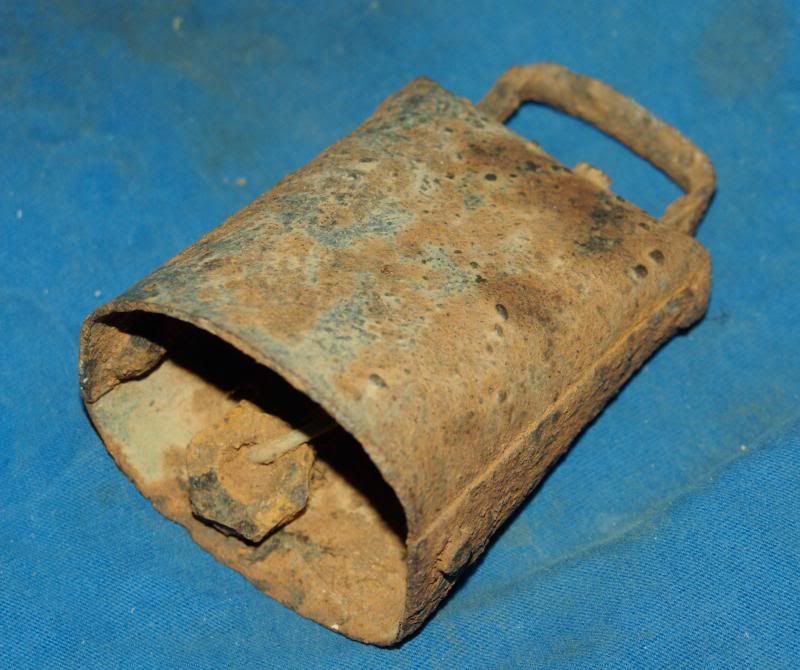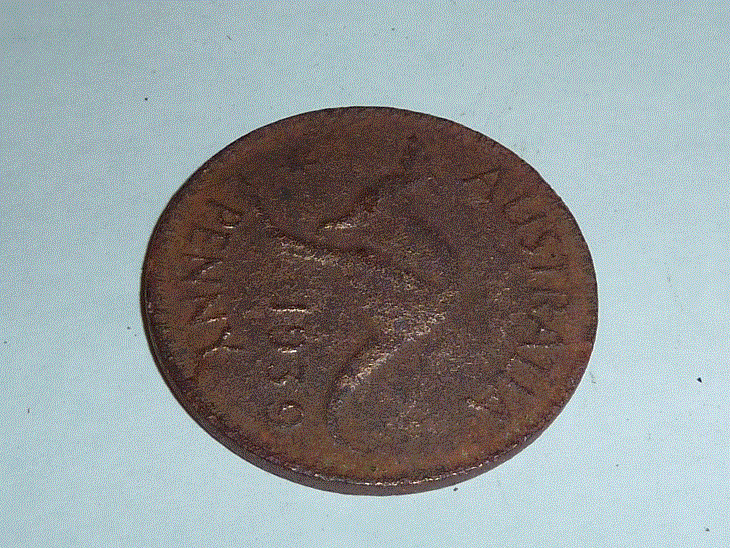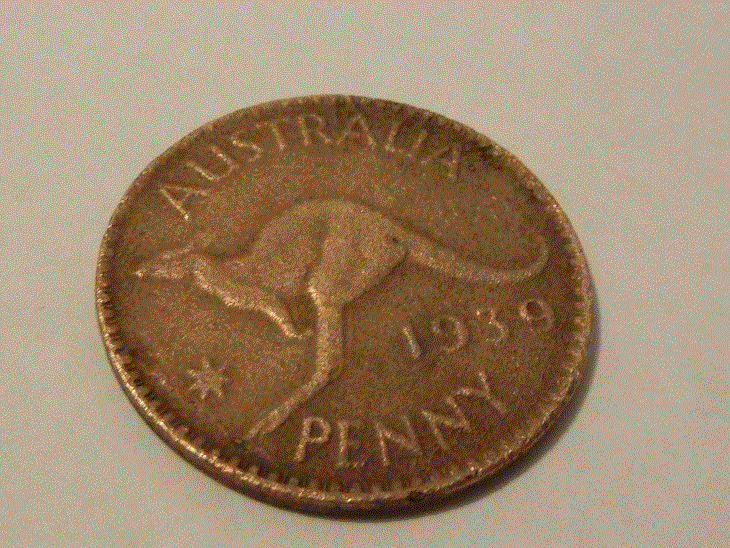Hi Pulltab magnet
This is a cut and paste of a "how to" I wrote on another metal detecting forum for electrolytic cleaning. You should find you get decent results with a little experimentation. Start with some non valuable relicss. This is the primary method I use for relics from your current site of interest and other may wish to give it a bash.
Regards
Dec
---------------------------------------------------------------------------------------
OK, firstly I'm going to assume you wish to do smaller items like coins, buckles and the like rather than larger items like machinery parts or artillary shells ( =-| )although the process is similar the power supply requirements become greater and more dangerous to the user and are there for outside the scope of this post.
Electrolytic cleaning 101
First off you must ask the question "Do I really wish to clean my artifacts this way?" There are other albeit slower methods that work equally well for some materials and are more environmentally friendly and also without risk to yourself and your item. As the process involves essentially a reverse electroplating action where surface layers a few microns thick are removed instead of added this would not be the method to clean a pristine and unique coin ready for sale for example .. although why you'd clean a pristine anything I am not quite sure? For cleaning something removed from the ground or the sea that needs to be identified, have markings revealed or cleaned up for your own personal collection then electrolysis is a viable and effective solution.
Some people will have you believe "I electrolysised my coin and it ate it away" this is generally untrue except at extreme high current levels. Alloys are an exception and will erode quite quickly. That's not to say they should never be electrolysised, they should just be carefully attended and checked very frequently to avoid pitting.
Electrolysis removes oxidation of all kinds well before it damages the host metal to any discernable degree unless you were to forget and leave it there for a day or two .... by which time with a plug pack powered system you'd be too busy putting out the fire to worry about the item.
Electrolysis removes all oxidisation, what collectors call "patina" is in fact oxidisation. Removing it can devalue your item, copper coins end up bright and shiny for example although they do re acquire their usual dull finish quite quickly minus the horrible green corrosion. If all that is holding your item together is the patina however then it's not going to end well.
You're going to see a lot of conflicting information about this on forums and on the web regarding electrolysis as a cleaning method, a lot of what is suggested works well but is unwise due to safety concerns and/or because it can damage your item. I've gotten to the point on forums where I just don't bother repeating myself any more because two posts later someone is saying "oh doing it such and such a way works fine for me" >_<.
I'm no guru but I am a technician by trade and did run an industrial chrome plating plant for a time so I have half a clue at least.
So, the other cleaning methods being outside the scope of this "how to" and taking as read you have decided electrolysis is the path you wish to follow then read on.
Materials and Equipment
Bath:-
--------
Start with a small non conductive container either plastic, Pyrex or glass, keep in mind that the process can involve temperatures up to 900 f at the point of which the alligator clips touch the item being cleaned so if using plastic do not allow the item or clip to touch the side of the container.
Electrolyte:-
---------------
Into your container pour plain tap water, distilled or otherwise has no benefit. Add Washing Soda (Sodium Carbonate) at a ratio of around 2 tea spoons per liter of water and mix it in thouroughly, "Arm and Hammer" and "Lectric" are two brands of washing soda that spring to mind. You'll find them with washing powder at the supermarket. You now have your electrolyte.
While most people use table salt in the water I do not support this as it gives off chlorine gas while the process is underway. Baking Soda (Sodium Bicarbonate) also works and while safe as far as chlorine gas goes does release salts that can corrode your item.
Regardless of what you use the process gives off Hydrogen gas so no smoking or naked flames and do it in a well ventilated area.
While electrolyte solution has no definitive life and can be used until it is black with a scum on the surface you should ALWAYS use a new solution when changing the material being cleaned. If you have brass and silver items, do one type and then change the solution and do the other. Failure to do so can result in plating due to the metals in solution and your silver may end up coppery in colour and vice versa.
Power supply:-
-------------------
Many people use a battery or battery charger, for smaller items this is huge over kill and adds danger to boot. For small items when you can monitor the process a plug pack works fine. Voltage is not critical with the upper limit being 24v for safety reasons, 9 to 12v being ideal. Ideally you want to pass about 300ma of current through a coin sized item being cleaned. I like to use a supply capable of 1 amp so as to not work it too hard. Something like a laboratory supply such as this one :-
http://www.jaycar.com.au/productView.asp?ID=MP3086
Would be a "Rolls Royce" solution allowing you to pre set the voltage and current there by avoiding the current limitation issues I will address shorty and allowing you to leave the process un attended safely for periods. I intend to purchase one myself but for most people it will be overkill so I'll continue as if you are using a plug pack.
Bare the wires and attach alligator clips to the ends of the wires being sure to mark positive and negative.
Confirm these with a multi meter if needed. Some people tell you that you can tell them apart as the negative lead will bubble in the solution, while this is true to some degree in a perfectly balanced setup BOTH ends bubble so don't risk it and check with a multi meter. If you get it the wrong way around you can errode or plate your item with metal from the anode.
The current is the critical issue here and sadly to say for the average hobbyist it is not really simple to regulate.
a) You could mix your electrolyte to a specific resistance by varying the ratio of washing soda to water but this is not easy to measure without specialised equipment.
b) You could use a regulated supply as shown above but this is expensive,
c) You could place a large 10watt wire wound resistor in line to limit the maximum delivered current to 300ma. Nominal values would be 40 Ohms for a 12v supply, 30 Ohm for a 9v supply or 20 Ohms for a 6v supply.
That said, plug packs vary greatly in voltage output both when under load and not under load so this is not a magic bullet. Also while the plug pack may not get too hot using this method the resistor will and so monitoring it is still required.
d) You can vary the distance between the item and the anode to achieve the desired resistance but again this is hard to measure for the hobbyist due to the equipment required.
e) What most people will do is just mix the electrolyte at the ratio specified, connect the plug pack in the correct polarity and monitor the process by way of placing your hand on the supply. Using a quality 1amp supply will not introduce enough current to damage an item and should be able to operate 15 or 20 minutes before becoming too hot to leave your hand on at which point it should be unplugged. That said .. DO NOT TAKE THIS FOR GRANTED!!! Unless using a regulated and cooled laboratory supply never leave the process un attended.
Also, it pays big dividend to use a small brushless fan to cool the supply or the resistors if you use that method. You can scrounge one from old electronics or buy one from a hobby store. If you choose carefully you will be able to power it from the same supply remembering to allow for the current load it will add. For your first experiments the fan will not be a must have item but for longevity of your set up it's a good idea.
Anode materials :-
------------------
The most common material used for your anode (which will have the positive lead attached) by home electrolytic cleaners is a stainless steel spoon. I can not stress this enough. Just don't use any stainless steel item as your sacrificial anode. If you do the process will result in Hexavalent Chromium being released into the electrolyte. See here :-
http://www.workplace-hygiene.com/articles/hex-chrom-update.html
Further, the resulting electrolyte becomes illegal to dispose of down the drain and must be allowed to evaporate and then the residue must be disposed of a a toxic waste facility.
I don't care what "Fred F***wit" from the "International metal detecting, asbestos munching and growing an extra head forums says" just
DON'T mmmm k?
Likewise, don't use zinc plated metals for similar reasons.
Aluminium works although it results in a slower process (sometimes a good thing) but by far and away the best is plain old untreated mild steel available as offcuts at a metal work shop near you.
The anode will over time be eaten away and become covered in rust and impurities, it will require periodic scrubbing and will need to be replaced now and again. You can also clean it by connecting another sacrificial plate and reversing the polarity but this is a little counter intuitive to me as it requires higher current levels and if you're going to use another sacrificial plate you might as well replace the original.
Technique
a) Take your bath and mix the electrolyte as outlined above.
b) Place the sacrificial anode on one side of the bath. Ideally it will not be totally submerged. Clip the positive lead from your supply to the anode out of the water.
c) Take the item to be cleaned and make sure an area is clean enough to make electrical contact, You can gently rub a tiny out of the way area with 0000 steel wool if needed. Clip the negative lead to this place.
d) Submerge the item to be cleaned on the opposite side of the container to the anode, clamp it in place totally submerged with as little of the alligator clip on the negative lead in the water as possible.
e) Plug in the power supply.
At this point the item and probably the anode will start to bubble, the cleaning process has begun. How long it will take depends on the material being cleaned and the current passing through it. Thin alloy such as identification tags should be removed every minute or two and gently brushed and inspected and then replaced if more is required. Coins and buttons will generally require 5 to 10 minutes and larger items such as buckles may take half an hour or more.
As the item cleans it will become black from the process. This is nothing more than carbon. Once all the corrosion and other undesirable material has been dissolved place it in the palm of your hand over a sink and cover it with Sodium Bicarbonate. Add a dob of toothpaste and a few drops of water and mix into a smooth paste. Using a toothbrush firmly but gently brush the entire object with the paste removing all the carbon. At this point you can decide if your item needs to go back in the bath for another treatment.
Considerations
a) Electrolysis is a "line of sight" process. The area of the item being cleaned facing the anode will clean most effectively. You can either turn the item several times during the process or arrange your bath so that there is a sacrificial anode on each side of the bath and your item hangs in the middle.
b) At no time while in the bath should the postively charged anode be allowed to come into contact with the negatively charged item being cleaned. Should this take place while power is applied you will at the least blow your plug pack and potentially trip your home circuit breakers and start a fire. Some people place a plastic mesh in the middle of the bath but this can cause shadows on the item being cleaned due to "line of sight" effect. Simplest solution is just take great care.
c) While highly unlikely 300ma is many times the current required to disrupt and potentially stop the human heart under "perfect storm" conditions. You'd be more likely to win lotto than to die using < 24v and 300ma but still
ALWAYS unplug the supply before inspecting, turning, brushing or touching the item in any way
You have been warned.
While every care has been made in preparation of these instructions and this process is undertaken safely by many thousands of people each year I accept NO responsibility for injury or negative results through failure to follow these instructions, unforeseen circumstances and the electrolytic cleaning process in general.
I may edit this guide at times as new techniques and information comes to hand and of course to correct the ever present spelling and grammar errors

Regards
Dec







